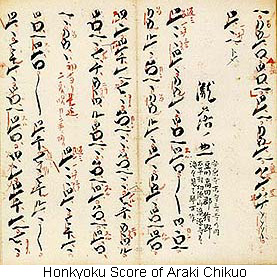In the beginning of the Edo Period, itinerant Buddhist priests (Komuso) of the Fuke sect who were previously employed as Samurai began to use a 1.8 feet long Shakuhachi for their mendicancy. This was called the Fuke Shakuhachi.
A retired Samurai, Kurosawa Kinko (1710-1771), who was the teacher at a temple of the sect, was commissioned to travel round Japan and established a style of art music on the instrument by composing new pieces based upon the repertoire of the Fuke Shakuhachi.
At the end of the Edo Period musicians of the Kinko school began to participate in the ensemble of Koto music, taking the place of the Kokyu, together with the Koto and Shamisen. The repertoire of the original solo pieces of the Kinko school is called Honkyoku (original pieces) while the repertoire of Koto pieces in which the Shakuhachi participates is called Gaikyoku (outside pieces).
Source: The International Shakuhachi Society
Some pieces from the Kinko-ryu are played in the Hijiri-ryū:
- HiFuMi-Hachigaeshi-no-shirabe
- Rembo-Nagashi
- Shika-no-tone
- Sokaku-Reibo
- Kyo-Reibo
- Sanya Sugagaki
- Shin Kyorei
- Takiotoshi no Kyoku
- Akita Sugagaki
- Azuma no Kyoku
- Kumoi-Jishi
(to be continued)
Fukuda Teruhisa’s Recording:

List of the Kinko-Ryu repertoire (source John Singer)
- HIFUMI HACHIGAESHI NO SHIRABE
- KOTOBUKI NO SHIRABE
- TAKI OTOSHI NO KYOKU
- AKITA SUGAGAKI
- KORO SUGAGAKI

- KYUSHU REIBO
- SHIZU NO KYOKU
- KYO REIBO
- MUKAIJI REIBO
- a. KOKU REIBO
b. KOKU REIBO (IKKAN RYU)
- BANSHIKI CHO
- SHIN KYOREI
- KIN SAN KYOREI
- YOSHIYA REIBO
- YUGURE NO KYOKU
- SAKAI JISHI
- UCHIKAE KYOREI
- IGUSA REIBO
- IZU REIBO
- REIBO NAGASHI
- SOKAKU REIBO
- SANYA SUGAGAKI
- SHIMOTSUKE KYOREI
- MEGURO JISHI
- GINRYU KOKU
- SAYAMA SUGAGAKI
- SAGARIHA NO KYOKU
- NAMIMA REIBO
- SHIKA NO TONEH
- HOSHOSU
- AKEBONO NO SHIRABE
- AKEBONO SUGAGAKI
- ASHI NO SHIRABE
- KOTOJI NO KYOKU
- KINUTA SUGOMORI
- TSUKI NO KYOKU

